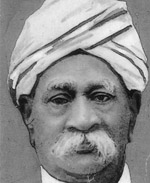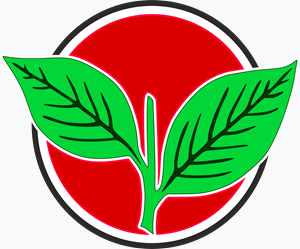
The All India Anna Dravida Munnetra Kazhagam is an Indian regional political party with great influence in the state of Tamil Nadu and the union territory of Puducherry. It is a Dravidian party founded by the former chief minister of Tamil Nadu M. G. Ramachandran (M.G.R.) at Madurai on 17 October 1972 as a breakaway faction from the Dravida Munnetra Kazhagam after M. Karunanidhi expelled him from the party for demanding an account as the party treasurer. The party is adhering to the policy of socialism and secularism based on the principles of C. N. Annadurai (Anna) collectively coined as Annaism by M.G.R. The party has won a seven-time majority in the Tamil Nadu Legislative Assembly and has emerged as the most successful political outfit in the state's history. It is currently the main opposition party in the Tamil Nadu Legislative Assembly.

The Dravida Munnetra Kazhagam is an Indian political party based in the state of Tamil Nadu, where it is currently the ruling party, and the union territory of Puducherry, where it is currently the main opposition.
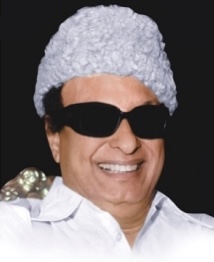
Maruthur Gopalan Ramachandran , popularly known by his initials M.G.R., was an Indian actor, politician, and philanthropist who served as the Chief Minister of Tamil Nadu from 1977 until his death in 1987. He was the founder and first general secretary of the All India Anna Dravida Munnetra Kazhagam. On 19 March 1988, Ramachandran was posthumously awarded the Bharat Ratna, India's highest civilian honour. Ramachandran is regarded as one of the most influential politicians of post-independence India.
Thamizhaga Munnetra Munnani (1988-1989) was a short-lived political party found by veteran Tamil film actor Sivaji Ganesan in the year 1988. Sivaji Ganesan had a long running relation with many political parties, with his first movie itself being a propaganda movie of Dravida Munnetra Kazhagam.

Dravidar Kazhagam is a social movement founded by E. V. Ramasami, also called Thanthai Periyar. Its original goals were to eradicate the ills of the existing caste system including untouchability and on a grander scale to obtain a "Dravida Nadu" from the Madras Presidency. Dravidar Kazhagam would in turn give birth to many other political parties, including Dravida Munnetra Kazhagam and later the All India Anna Dravida Munnetra Kazhagam.
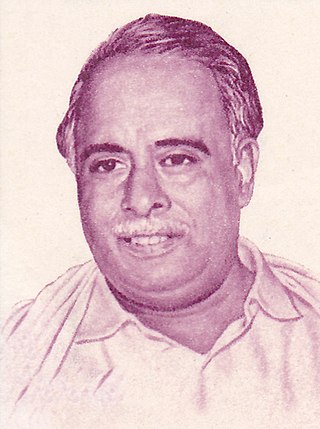
Conjeevaram Natarajan Annadurai, popularly known as Anna, also known as Perarignar Anna, was an Indian politician who served as the fourth and last Chief Minister of Madras State from 1967 until 1969 and first Chief Minister of Tamil Nadu for 20 days before his death. He was the first member of a Dravidian party to hold either post.

The thirteenth legislative assembly election, of Tamil Nadu was held on 8 May 2006. It was held for all 234 constituencies to elect the government in the state for the following five years. The votes were counted three days later on 11 May 2006 and all the results were out by the end of the day. The Dravida Munnetra Kazhagam-led (DMK) front won the elections, with the DMK emerging as the single-largest party with 96 seats, and its leader, M Karunanidhi was sworn in as Chief Minister for a fifth and final term. This election marked the first time the state saw a hung assembly with no party gaining a majority of its own. As a result, DMK formed a minority government with its allies, which is the first in the state since the 1952 election. 13th Assembly was instituted due to this election.

V. R. Nedunchezhiyan was an Indian politician and writer. He served thrice as the Chief Minister of the state of Tamil Nadu, India. He was also senior cabinet minister under the governments of C. N. Annadurai, M. Karunanidhi, M. G. Ramachandran and J. Jayalalithaa. For his literary contributions, he was also known as "Navalar" or the eloquent.
Dravidian nationalism, or Dravidianism, developed in Madras Presidency which comprises the four major ethno-linguistic groups in South India. This idea was popularized during the 1930s to 1950s by a series of widespread and popular movements and organizations that contended that the South Indians formed a racial and a cultural entity that was different from the North Indians. Dravidianists argue that the Brahmins and other upper castes were originally Aryan migrants from outside of India, and that they imposed their language, Sanskrit, religion and heritage on the Dravidian people. The claim is based on widespread evidence of the genetic differences between North and South Indians, the linguistic differences between the two regions, and the fact that Indo Aryan Languages share a common ancestor with European languages such as English and likely originated outside of India. The hypothesis has ancient origins based on Sangam literature and the concept of Tamilakam but was codified in its modern form by E. V. Ramasami Periyar. The theory is contested by supporters of Hindutva who see it as a threat to Hindu essentialism.
Politics of Tamil Nadu is the politics related to the Indian state of Tamil Nadu.
Erode Venkatappa Krishnasamy Sampath, usually referred to as E. V. K. Sampath was a prominent politician from Tamil Nadu, India. He was an advocate of the Dravidian Movement of Periyar E. V. Ramasamy and was considered by some as his political heir. He later split from Periyar's Dravidar Kazhagam to form Dravida Munnetra Kazhagam (DMK) along with C. N. Annadurai. In spite of being one of the founders of DMK he later left and formed his own party, by the name, Tamil National Party. Nevertheless, he later merged his party with the Indian National Congress. He is a former Member of Parliament from the constituency of Namakkal.
Dravidian parties rose to power and prominence in the political stage of Tamil Nadu, a state in India, in the 1960s. The rise in power and political support was gradual until Dravida Munnetra Kazhagam (DMK), a Dravidian party, formed the government in the state in 1967. Although since the 1970s the Dravidian parties have met with many break-aways and have taken rival stances against each other, the seat of power in Tamil Nadu has been with one or another Dravidian party. The increase in popularity of the Dravidian parties in the 1960s is attributed to several factors, including the fall of popularity of the Congress Government in the centre and the north–south disparity, as claimed by the Dravidian politics. The series of events climaxed with anti-Hindi agitation which led to the downfall of popularity of the then Indian National Congress government in the state and the eventual rise of Dravidian parties to power.
Tamil cinema has played a vital role in Dravidian politics in the South Indian state of Tamil Nadu. Films have been influential in Indian politics since the days of the British Raj, when movies were used for anti-British propaganda. Nevertheless, the leaders of the Indian National Congress viewed movie media with contempt. It was the Dravida Munnetra Kazhagam (DMK), a Dravidian party, that made extensive use of this media for propaganda purposes. Adversaries of Dravidian parties despised the use of films and screen popularity for political gain, and Congress leaders like K. Kamaraj questioned the possibility of movie stars forming governments.

The eleventh legislative assembly election of Tamil Nadu was held on 2 May 1996. The Dravida Munnetra Kazhagam (DMK) led front won the election and its leader M. Karunanidhi, became the chief minister. This was his fourth term in office. S. Balakrishnan, also known as So. Balakrishnan, of Tamil Maanila Congress, became the Leader of the Opposition. The incumbent All India Anna Dravida Munnetra Kazhagam (AIADMK) government was defeated in a landslide with its general secretary and outgoing chief minister J. Jayalalithaa losing the election from the Bargur constituency. She became the first Incumbent Chief Minister since M. Bakthavatsalam in 1967 to lose her own constituency.

The ninth legislative assembly election of Tamil Nadu was held on 21 January 1989. Dravida Munnetra Kazhagam (DMK) won the election and its leader M. Karunanidhi, became the Chief Minister. It was his third term in office. The DMK was in power only for a short term, as it was dismissed on 31 January 1991 by the Indian Prime minister Chandra Shekhar using Article 356 (Otherwise) of the Indian Constitution.
K. A. Mathiazhagan was an Indian politician and co-founder of the Dravida Munnetra Kazhagam (DMK). He served as the Finance Minister, Minister of Food, Revenue and Commercial Taxes in the Tamil Nadu government and Speaker of the Tamil Nadu Legislative Assembly.
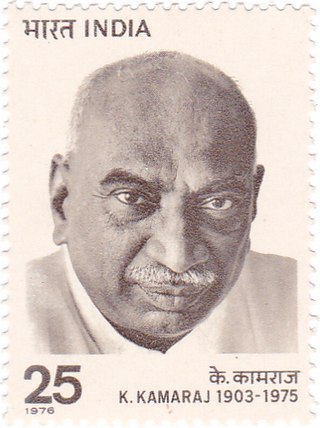
The third legislative assembly election to the Madras state was held on 21 February 1962. The Indian National Congress party, led by K. Kamaraj, won the election. Dravida Munnetra Kazhagam made significant in-roads in the election and emerged as the second party for the first time by winning 50 seats. 1962 Election remains the most recent election in which Indian National Congress to form a majority Government in the State as its support was heavily declined due to rise of Dravidian political parties.
S. Natarajan Udayar was an Indian politician and 3 time DMK MLA from Thanjavur Constituency. A close friend and supporter of Periyar E.V. Ramaswamy, he was an early member of Dravidar Kazhagam. His association with Aringar C N Annadurai made him part ways with E.V.R. politically and join Dravida Munnetra Kazhagam (DMK) as one of the earliest and founding members of DMK.
R. M. Veerappan was an Indian politician, an early Dravidian Leader, and a film producer and screenwriter from the Indian state of Tamil Nadu. He was the founder and leader of the MGR Kazhagam party. He served as a Cabinet Minister in five governments from 1977 to 1996, was a three-time Member of Legislative Council and a two-time member of the Legislative Assembly. He was the Leader of the House for Legislative Assembly and Leader of ADMK party of the Legislative Council. He was the architect behind the ADMK organization, unified the MGR fan clubs for the party formation. He was called as the 'Chanakya' of AIADMK politics in the 70's and 80's.
The AIADMK-led Alliance is an Indian regional political party alliance in the state of Tamil Nadu and the union territory of Puducherry led by the Dravidian party All India Anna Dravida Munnetra Kazhagam founded by the former chief minister of Tamil Nadu M. G. Ramachandran (M.G.R.).


